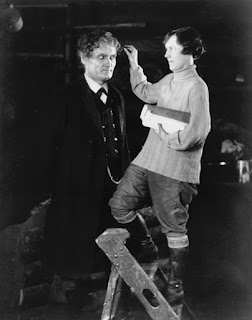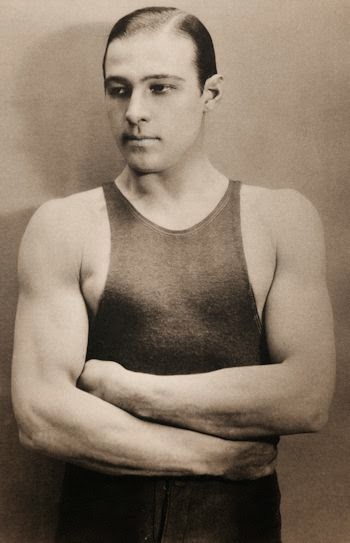The Mountain Eagle - For the Love of Film III
 |
| Nita Naldi as Beatrice Brent (Image: BFI) |
 |
| Nita Naldi and Bernard Goetzke |
Hitchcock recalled greeting Nita Naldi at the Munich train
station. She stepped off the train, he
wrote, and “Munich quite audibly gasped.”
She was every inch the diva:
…glamorous, dark, Latin, Junoesque, statuesque,
slinky, with slanting eyes, four-inch heels, nails like a mandarin’s and a
black dog to match her black-swathed dress.
She also traveled with her “Papa,” who was not her father,
but her longtime beau and future husband J. Searle Barclay.
Hitchcock further recalled,
I shall never forget one afternoon. We had been working hard all the day, and
Nita was nearly all in. She had to play
one more scene, where she was cleaning Malcolm Keen’s rifle when a face
appeared at the window and she pointed the gun at him.
The scene was going well, when, just as she turned
the gun to the window, I saw it waver.
It veered from side to side. It
moved up and down. It went round in
circles.
Then, without a word, Nita tilted to one side and
fell headlong.
The floor was very hard . . . The set was built on a
foundation of stones set in cement.
Before the camera had even stopped turning, she had recovered. And all she said was: “Why don’t they build these lousy sets right
over here? This floor’s too gol-darned
hard for comfort!”
Well, we already know Nita was a handful and one of the many silent stars I wish I’d been able to meet and have dinner with. Given Hitch’s love of food and earthy, naughty women, Nita must have been much good fun during the shoot. We know Hitchcok and Alma socialized with Nita in Paris in 1926. I wonder if they had any further contact later in New York. If they did, regretably, there is no record of it.
 |
| Nita Naldi and Malcolm Keen |
Alfred Hitchcock did not think much of the film and felt it
was best forgotten. During the
interviews chronicled by Francois Truffaut in the indispensible Hitchcock / Truffaut, Hitchcock
described the film as being "awful" and added "[he was] not
sorry there are no known prints."
Was this a true sentiment or just
another of the Master’s beloved quips?
We’ll never know.
So what can we say
about The Mountain Eagle? Let me pause right here to note that I owe much of
what follows to the late J. L. Kuhns and his research on this film. His paper Filmography
Notes on The Mountain Eagle, presented during the 1996 Hitchcock Conference
at Baylor University, filled loads of holes for me; I’m grateful for the information.
 |
| On the set, a famous image of Hitchcock and Alma as he's directing The Mountain Eagle (Image: BFI) |
Beatrice
Brent (Nita Naldi), school teacher in a small mountain village, incurs the
enmity of Pettigrew (Bernard Goetzke), the local Justice of the Peace and owner
of the village stores, because he believes that she encourages the attentions
of his son Edward (John F. Hamilton), a cripple, who takes evening lessons.
Pettigrew, while questioning Beatrice, is himself influenced by her charm and
attempts liberties which she strongly resents. He is so furious at the rebuff
that he proclaims her as a wanton and she is driven from the village by the
inhabitants. Beatrice is saved from their fury by a mysterious stranger known
as Fearogod (Malcolm Keen), who lives a solitary life in a cabin to which he
takes her for shelter. To stop all scandal, Fearogod takes Beatrice down to the
village and compels Pettigrew to marry them, explaining to her that he will
help her to get a divorce. Beatrice, however, is content to leave the situation
as it is, but Pettigrew, furious with rage, takes advantage of the fact that
his son has left the village and arrests Fearogod for his murder. In spite of
the fact that there is no vestige of evidence that young Pettigrew has been
murdered, Fearogod is kept in prison for over a year, when he decides to
escape. He finds that his wife has a baby and he goes off with them to the
mountains. When they find that the baby is taken ill, Fearogod goes back to the
village for a doctor, where he sees old Pettigrew. Some doubt as to which of
the men is going to attack the other first is settled by an onlooker firing off
a gun which wounds Pettirgrew in the shoulder. The sudden return of his son
Edward convinces the old man of the futility of proceeding with his accusations
of murder, so he makes the best of matters by shaking hands with the man he
persecuted and all is supposed to end happily.
Okay, so it's not reading like Gone With the Wind, is it?
Okay, so it's not reading like Gone With the Wind, is it?
 |
| Bernard Goetzke getting a hair and makeup adjustment from Alma Reville (Image: BFI) |
A contemporary
review of the film in Kinematograph Weekly stated that "Alfred
Hitchcock's direction is, as usual, thoroughly imaginative," but
complained that "he has rather over-stressed the slow tempo, and has had a
story which is too full of unconvincing twists." It praised the characterization
and noted that "many individual scenes are very cleverly handled,"
concluding, "the mountain scenery is good, and the small village interiors
and exteriors are also sound. Baron Ventimiglia's photography is
excellent."
 |
| John Hamilton as Edward and Bernard Goetzke as Pettigrew (Image: BFI) |
In Brief: The story of a feud between two men in a small mountain village, which is
lacking in conviction but of interest because of skillfull direction and good
acting.
Suitability: The undoubted artistic merits of the production
should compensate for the weakness of the story.
Direction: The producer, Alfred Hitchcock, has not been
particularly well served by his author, and in spite of skillful and at times
brilliant direction, the story has an air of unreality. The locality is not
indicated, though the village in which the action takes place is obviously
continental. This ambiguity may be intentional and to account for the way in
which Pettigrew imposes his will on the people with as utter a disregard for
law or justice as any villain of Western drama. That a man could be kept in prison
for a year on a charge for which there is not the slightest evidence, and in
spite of the fact that the prisoner is the most popular man in the district
while the oppressor is the worst hated, is against all reason and lacks
conviction as much as Pettigrew's facile repentance at the end.
Acting: Bernhard Goetzke gives a fine performance as Pettigrew, and his strong
and intellectual face makes his conduct all the more incongruous. Malcolm Keen
is admirable as Fearogod, and Nita Naldi achieves considerable success in a
part which has fewer opportunities than generally fall to her share. Many small
character parts are most admirably played and very skillfully directed.
Staging
and Photography: Beautiful pictures of
mountain scenery in summer and winter, and picturesque timber interiors, are
shown with unusually artistic lighting effects and excellent photography.
 |
| Bernard Goetzke as Pettigrew (Image: BFI) |
Some weeks ago I mentioned his first production, The Pleasure Garden. The
Lodger is his third picture, although it comes second in order of release
to the public. His second, The Mountain
Eagle, is due in May and incidentally, is one of the finest pictures of the
year.
The Lodger
is not so brilliant as The Mountain Eagle,
but nevertheless is well worth seeing.
Is that tantalizing,
or what? Me? I’m still trying to wrap my
head around Nita Naldi as a prim schoolmarm who has the wherewithal to handle a
shotgun. Judging only on the stills alone, this looks like it would be a film well worth watching. Atmospheric, dark, forboding and some hauntingly beautiful stills extant of leading lady Nita Naldi. The BFI has a small collection, most of which I culled from their website to illustrate this article. The Margaret Herrick Library holds what is the largest collection of stills for the film, between 30-35 images which came from the Hitchcock collection. Two 8x10 vintage stills were recently auctioned with a hammer price of nearly $500!
No poster art is known to exist, save a single lobby card in a private collection showing a german shepherd. No clue how the dog fits into the story, but he reminds me of another silent superstar, Rinty.
Additional information and some contemporary articles can be found on the Nita Naldi website, scroll down on the filmography page for some more good stuff on The Mountain Eagle.
Alfred Hitchcock’s 1926 film The Mountain Eagle is Number 1 on the BFI list as one of the MostWanted lost films.
Luke McKernan of The Bioscope (an incredibly informative and well produced blog I cannot recommend more highly) gave us a review of The Mountain Eagle during his brilliant and inspired Festival of Lost Films in 2008. I wish he’d do this again!
 |
| Malcolm Keen as Fearogod |
Our work, however, is not complete. I hope that people reading my humble musings have read the rest and have donated a little cash for the kitty. I know times are tough for everyone, myself included. A $5 donation for the love of film would mean so much to the National Film Preservation Foundation and make a rare film available for online streaming. Is $5 such a hardship, I hope it's not. You may not have heard of Graham Cutts before the blogathon, but you certainly know the name and films of Alfred Hitchcock. Do it for Hitch!
For the Love of Film is a fundraising blogathon hosted by The Self-Styled Siren, Ferdy on Films and This Island Rod. I am honored to be a participant for such a worthy and noble cause. If you like what you've been reading, or not, please consider making a donation to the NFPF to help reach the goal of making what remains of the 1923 film The White Shadow available for online streaming. Any amount is a welcome and is tax deductable. Be it $5, $10, $20 or $100, no amount it too small to help reach the goal of $15,000. Donate Here or hit the pic of Hitch or the donatation button to the right. By all means, just donate!


Comments
......and a donation will be the next thing I have to do; but as a Brit and a contrarian, I'm not going to do it for Hitch; he doesn't need the help too much; I'll do it for Graham Cutts, a fine director of fine films, maligned by Hitch when too dead to defend himself or put the record straight about who did what on White Shadows....a contemporary report of the filming at the studio fails to mention Hitch at all....but Hitch being Hitch, and history being written by the winners, that malign view continues in certain circles with little opposition. If only The Rat Trilogy, for example, was widely available....anyway, thank you and the other bloggers for not adding to the disinformation about Mr Cutts out there, some of which came from the original press release on the White Shadows discovery...for which some people, who I will not name, should hang their heads in shame for displaying such ignorance about film history....but a chunky gift to the NFFP follows. Congratulations again on a fine piece, and all power to your collective elbows.
Could that be J. Searle Dawley? (a famed Edison director).